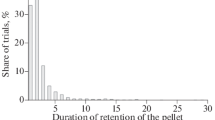Summary
The stimulation effectiveness of different monosaccharides (Table 1) was studied by touching the tarsi of hungry flies with solutions of the monosaccharides and observing the extension of the proboscis. The effectiveness was related to the conformation of the sugars.
According to the given hypothesis, monosaccharides in the C1 conformation are attached at the glucose (i.e. C1) site, those in the 1C conformation at the fructose (i.e. 1C) site.
The importance of the groups on the different carbon atoms of the pyranose ring for the stimulation effectiveness of the molecule is discussed. For monosaccharides in the C1 conformation, the stimulating effectiveness depends on the orientation of the hydroxyl group on C-3 and also on the presence and position of other groups. As far as the monosaccharides in the 1C conformation are concerned, the orientation of the hydroxyl group on the second carbon atom of the ring is of major importance.
The hypothesis given for the sense of taste of Phormia is applied to that of other insects using data given by other workers in the literature.
Zusammenfassung
Verschiedene Monosaccharide (Tabelle 1) wurden durch Berühren der Tarsen hungriger Fliegen und Beobachten der Rüsselreaktion auf ihre Reizwirksamkeit geprüft. Diese wird zur Konformation der Zucker in Beziehung gesetzt.
Nach der vorgeschlagenen Hypothese werden Monosaccharide mit C1-Konformation am Glucose-(d.h. C1-)Bindungsort, die in 1C-Konformation vorliegenden am Fructose-(d.h. 1C-) Bindungsort angelagert.
Die Bedeutung der an den verschiedenen C-Atomen des pyranoiden Rings sitzenden Gruppen für die Reizwirksamkeit des Moleküls wird diskutiert. Bei den Monosacchariden mit C1-Konformation ist die Position der OH-Gruppe an C-3 für die Reizwirksamkeit entscheidend, deren Stärke hängt jedoch auch vom Vorhandensein oder Fehlen anderer Gruppen und deren Stellung ab. Bei den Monosacchariden mit 1C-Konformation kommt die Schlüsselstellung der OH-Gruppe am zweiten Ring-C-Atom zu.
Die für den Geschmackssinn von Phormia aufgestellte Hypothese wird durch Heranziehen von Literaturangaben auf den anderer Insekten angewendet.
Similar content being viewed by others
Literatur
Barry, C. P., Honeyman, J.: Fructose and its derivatives. Advanc. Carbohyd. Chem. 7, 53–98 (1952).
Dethier, V. G.: The physiology and histology of the contact chemoreceptors of the blowfly. Quart. Rev. Biol. 30, 348–371 (1955).
—: The physiology of insect senses. London: Methuen & Co. 1963.
—, Evans, D. R., Rhoades, M. V.: Some factors controlling the ingestion of carbohydrates by the blowfly. Biol. Bull 111, 204–222 (1956).
Eliel, E. L., Allinger, N. L., Angyal, S. J., Morrison, G. A.: Conformational analysis. New York-London-Sidney: Interscience Publishers 1965.
Evans, D. R.: Depression of taste sensitivity to specific sugars by their presence during development. Science 138, 327–328 (1961).
—: Chemical structure and stimulation by carbohydrates. In: Olfaction and taste, vol. I (ed. Y. Zotterman), p. 165–176. Oxford: Pergamon Press 1963.
Frisch, K. v.: Über den Geschmackssinn der Bienen. Z. vergl. Physiol. 21, 1–157 (1935).
Haslinger, F.: Über den Geschmackssinn von Calliphora erythrocephala Meigen und über die Verwertung von Zuckern und Zuckeralkoholen durch diese Fliege. Z. vergl. Physiol. 22, 614–640 (1935).
Hassett, C. C., Dethier, V. G., Gans, J.: A comparison of nutritive values and taste thresholds of carbohydrates for the blowfly. Biol. Bull. 99, 446–453 (1950).
Ishikawa, S.: Maxillary chemoreceptors in the silkworm. In: Olfaction and taste vol. II (ed. T. Hayashi), p. 761–777. Oxford: Pergamon Press 1967.
Morita, H., Shiraishi, A.: Stimulation of the labellar sugar receptor of the fleshfly by mono- and disaccharides. J. gen. Physiol. 52, 559–583 (1968).
Omand, E., Dethier, V. G.: An electrophysiological analysis of the action of carbohydrates on the sugar receptor of the blowfly. Proc. nat Acad. Sci. (Wash.) 62, 136–143 (1969).
Pigman, W., Isbell, H. S.: Mutarotation of sugars in solution: Part I. History, Basic kinetics, and composition of sugar solutions. Advanc. Carbohyd. Chem. 23, 11–57 (1968).
Reeves, R. E.: The shape of pyranoside rings. J. Amer. chem. Soc. 72, 1499–1506 (1950).
Salama, H. S.: The function of mosquito taste receptors. J. Insect Physiol. 12, 1051–1060 (1966).
Shallenberger, R. S., Acree, T. E.: Chemical structure of compounds and their sweet and bitter taste. In: Handbook of sensory physiology, vol. IV/2. Berlin-Heidelberg-New York: Springer 1971 (im Erscheinen).
Schmidt, A.: Geschmacksphysiologische Untersuchungen an Ameisen. Z. vergl. Physiol. 25, 351–378 (1938).
Schoonhoven, L. M., Dethier, V. G.: Sensory aspects of host-plant discrimination by lepidopterous larvae. Arch. néerl. Zool. 16, 497–530 (1966).
Stanek, J., Cerny, M., Kocourek, J., Pacak, J.: The monosaccharides. New York-London: Academic Press 1963.
Weis, I.: Versuche über die Geschmacksrezeption durch die Tarsen des Admirals, Pyrameis atalanta L. Z. vergl. Physiol. 12, 206–248 (1930).
Author information
Authors and Affiliations
Additional information
Mit Unterstützung durch die Deutsche Forschungsgemeinschaft.
Rights and permissions
About this article
Cite this article
Pflumm, W. Zur Reizwirksamkeit von Monosacchariden bei der Fliege Phormia terraenovae . Z. vergl. Physiologie 74, 411–426 (1971). https://doi.org/10.1007/BF00341405
Received:
Issue Date:
DOI: https://doi.org/10.1007/BF00341405




